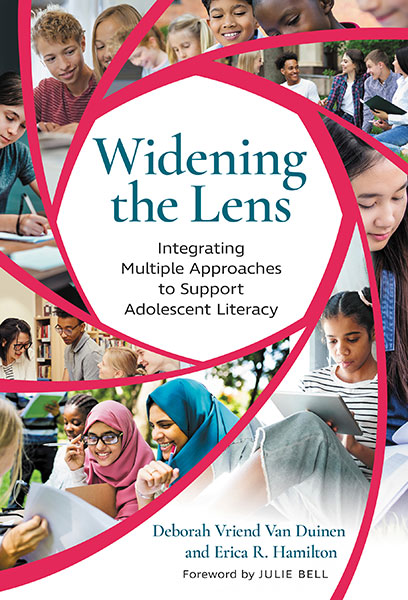Professors: Request an Exam Copy
Print copies available for US orders only. For orders outside the US, see our international distributors.
Deborah Vriend Van Duinen, Erica R. Hamilton
Foreword by: Julie Bell
Publication Date: February 23, 2024
Pages: 160
Series: Language and Literacy Series

Drawing on an asset-based approach to adolescents and their literacy practices, this book is a powerful resource for secondary teachers across all content areas. The authors encourage a “widened lens” approach that considers varied perspectives and research findings when engaging in multiple and often competing initiatives, issues, and pedagogies. Using examples from their own and others’ classroom experiences, the authors explore numerous theoretical and practical understandings of literacy to inform classroom instruction. They discuss different theories of literacy instruction and the ways that sociocultural and cognitive approaches to literacy like the Science of Reading and Whole Language can work in concert with each other. Readers will find relevant information about adolescents’ multiliteracies, text selection and complexity, and meeting the needs of diverse learners. With suggested resources, teaching strategies, and discussion questions throughout, this is an ideal text for teacher education courses, professional learning communities, and professionals who want to learn more about how to support adolescents’ literacy development.
Book Features:
Deborah Vriend Van Duinen is a professor of English Education at Hope College, Holland, MI. Erica R. Hamilton is an associate professor of literacy studies at Grand Valley State University, Allendale, MI.
“Changing one’s mindset is often a challenge, but by using the ‘yes, and’ approach there is a feeling of safety in taking that risk. This book is a much-needed primer for the preservice and secondary teacher who often misjudge or doubt the relevance of literacy in the content areas.”
—Teachers College Record
“The authors use their widened lens metaphor to describe three key approaches: science of reading, whole language, and balanced literacy. Their descriptions help readers situate themselves in the field and determine which parts of each approach will best serve their students…. This is a book I wish I had owned as a preservice teacher and in my early years of teaching, and it is a book I’m excited to share with the teachers I work with now.”
— From the Foreword by Julie Bell, associate professor of teacher education, University of Nebraska at Omaha
“This timely book provides an integrated, multifaceted approach to adolescent literacy instruction. Chock full of strategies for preservice and beginning educators, the authors create a much-needed guide for navigating the complexities of adolescent literacy, including skill development, engagement and motivational factors, as well as disciplinary demands that cross subject areas.”
—Hiller A. Spires, executive director and professor emerita, North Carolina State University
Contents
Foreword Julie Bell xi
Acknowledgments xv
Introduction 1
Adolescent Literacy 2
Theories 2
A Widened Lens Metaphor and a “Yes, And” Approach 3
1. Concepts, Definitions, and Beliefs 7
Literacy 7
Literacy Instruction 9
(Re)Defining Adolescence and Adolescents 10
(Re)Defining Adolescent Literacy 13
“Yes, And” Approach 14
Moving Forward 25
2. Adolescents’ Literacy Skills 27
Three Approaches to Literacy Instruction 28
Reading and Writing Skills 31
Developing and Supporting Adolescents’ Reading and Writing Proficiency 41
“Yes, And” Approach to Adolescents’ Reading and Writing Skills 43
Moving Forward 44
3. Adolescents’ Literacy Contexts and Practices 45
Context 46
Literacy in Context 46
Adolescents’ Literacy Practices in Context 53
Acknowledging and Valuing Adolescents’ Literacy Contexts and Practices 55
Integrating Adolescents’ Literacy Contexts and Practices 57
“Yes, And” Approach to Adolescents’ Literacy Contexts and Practices 59
Moving Forward 60
4. Identifying and Using Texts 61
Identifying Texts 61
Considering the Complexity of Texts 64
Using Texts for Instructional Purposes 73
“Yes, And” Approach to Identifying and Using Texts 76
Moving Forward 77
5. Literacy Strategies Across Subject Areas 79
Literacy Skill Development 79
Using Literacy Strategies to Support Adolescents’ Literacy Skill Development 83
Using Literacy Strategies for Instructional Purposes 93
“Yes, And” Approach to Using Literacy Strategies Across Subject Areas 96
Moving Forward 97
6. Disciplinary Literacy Instruction 99
Disciplinary Literacy 99
Disciplinary Literacy Instruction 101
“Yes, And” Approach to Disciplinary Literacy Instruction and Literacy Strategies 113
Moving Forward 114
Conclusion 117
Key Takeaways: “Yes, And” Considerations 118
Moving Forward 119
References 121
Index 131
About the Authors 137
Professors: Request an Exam Copy
Print copies available for US orders only. For orders outside the US, see our international distributors.